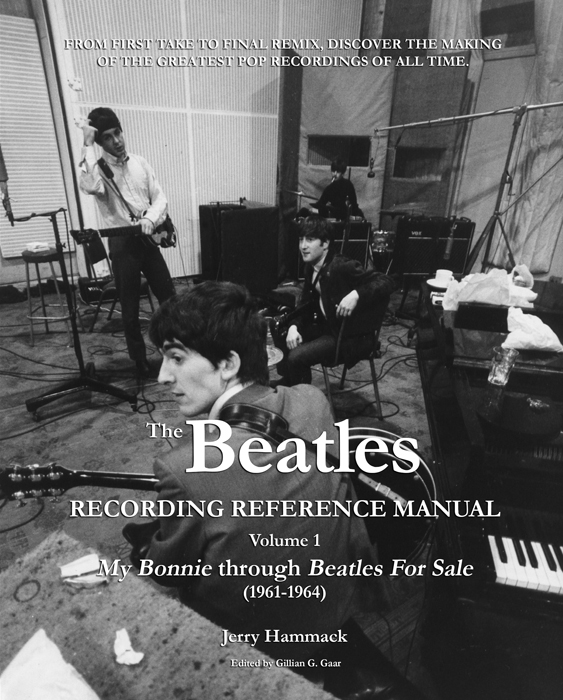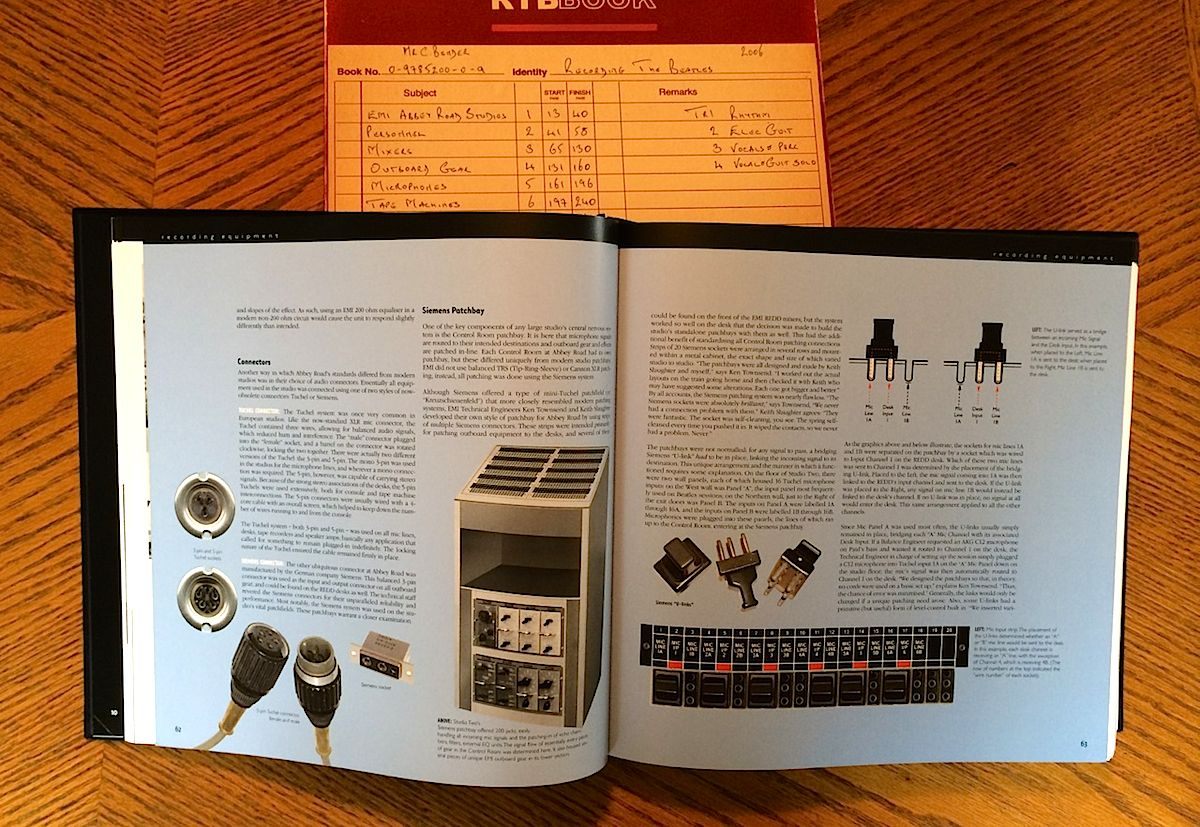

With a detailed look at every piece of studio gear used, full explanations of effects and recording processes, and an inside look at how specific songs were recorded, Recording The Beatles is a must-have for any Beatles fan or recording engineer. Recording the beatles Download recording the beatles or read online books in PDF, EPUB, Tuebl, and Mobi Format. Click Download or Read Online button to get recording the beatles book now. This site is like a library, Use search box in the widget to get ebook that you want.
| Author | Kevin Ryan and Brian Kehew |
|---|---|
| Language | English |
| Genre | Non-fiction |
| Publisher | Curvebender Publishing |
| 2006 | |
| Media type | Print (Hardback) |
| Pages | 540 |
| ISBN | 0-9785200-0-9 |
Recording The Beatles (ISBN0-9785200-0-9) is a book by Kevin Ryan and Brian Kehew, published by Curvebender Publishing in September 2006.
The book's full title is Recording The Beatles: The Studio Equipment and Techniques Used To Create Their Classic Albums. It addresses the technical side of The Beatles' sessions and was written with the assistance of many of the group's former engineers and technicians, chief among them Peter K. Burkowitz,[1] designer of the REDD mixing console.[2] The book looks at every piece of recording equipment used at Abbey Road Studios during the Beatles' sessions, including all microphones, outboard gear, mixing consoles, speakers, and tape machines. Each piece is examined in great detail, and the book is illustrated with hundreds of full color photographs, charts, drawings and illustrations. How the equipment was implemented during the group's sessions is also covered. The effects used on the Beatles' records are addressed in great detail, with full explanations of concepts such as ADT and flanging. The Production section of the book looks at the group's recording processes chronologically, starting with their 'artist test' in 1962 and progressing through to their final session in 1970. The book contains several rare and unseen photos of the Beatles in the studio. The studio personnel and the studio itself is examined.
The authors spent over a decade researching the subject matter and offer up their findings in exhaustive detail. The 540-page hardcover book has been highly praised not only for its massive scope, but also for its presentation. The 'Deluxe' version, released in September 2006, was housed in a replica EMI multi-track tape-box, complete with faux time-worn edges. Rather than a listing of the tape's contents, the back of the box featured the book's contents, hand-written by former Beatles tape-op and engineer, Ken Scott. The book was also accompanied by several 'bonus items', including reproductions of never-seen photos of the Beatles. The first printing of 3,000 books sold out in November 2006, and a second printing was released in February 2007. The book is currently in its sixth printing.
The book has been critically praised by recognized Beatles authority Mark Lewisohn (who also contributed the book's Foreword), The New York Times,[3][4]Mojo magazine (which gave it 5 stars), Beatles engineers Norman Smith, Ken Scott, and Alan Parsons, Yoko Ono, and many other individuals directly involved with the Beatles' work. The release of the book was celebrated in November 2006 with a party in Studio Two at Abbey Road.[5] In attendance were most of the Beatles' former engineers and technicians.
Contents[edit]
Chapter 1: EMI/Abbey Road Studios
Chapter 2: Personnel
Chapter 3: Mixers
Chapter 4: Outboard Gear
Chapter 5: Microphones
Chapter 6: Tape Machines
Chapter 7: Speakers & Amplifiers
Chapter 8: Effects
Chapter 9: Studio Instruments
Chapter 10: Other Studios
Chapter 11: Production (1962–1970)
References[edit]

- ^Peter Karl Burkowitz 1920-2012 Obituary by the AES
- ^Recording The Beatles
- ^The Beatles - Books - Report - New York Times
- ^Waiting to Take You Away on a Fact-Filled Tour - New York Times
- ^Recording The Beatles
External links[edit]
- Official website
- Media >Book/eBook
Could this be the definitive guide to the Beatles' recording sessions?
The KLF, in their book The Manual (How To Have A Number One Hit The Easy Way), say: 'You will find engineers everywhere trying to impress you with the fact that Sergeant Pepper was recorded on a four-track. This is of course as relevant as the fact that no JCBs were used in the construction of the Great Pyramid.'
Recording The Beatles Book Pdf Online
Every engineer knows about Pepper being done on four tracks. The more intelligent engineer will have realised that there were perhaps other factors involved in making Beatles recordings what they are: room ambience and probably lots of boxes with valves, that sort of thing. But it's actually very hard to find concrete information about how these recordings were made, and what they were made with. Until now, that is...
Much as archaeologists have spent no end of time investigating the mechanics involved in building a pyramid, Kehew and Ryan have made it their business to find out everything there is to know about the the methods by which the Beatles' music was recorded. Of course, given that this took place considerably less than 4000 years ago, and that most of the people involved are still very much alive, their task was probably a great deal less speculative than that of the archaeologists. After all, you're going to get much more definite answers if you can talk to the people involved and look at the equipment they used than you will if you're sitting around looking at a 40-ton block of stone and trying to work out how a bunch of guys in loincloths, with no JCBs, managed to move it about and use it to create pleasing geometric shapes.
Recording The Beatles is a huge book, and there's a simply awesome amount of information collected within its 500+ pages. It is the result of over a decade of research, in which Kehew and Ryan tracked down and interviewed as many ex-EMI staff as they could find, located and photographed examples of nearly every piece of studio equipment in use at Abbey Road between 1962 and 1970 and spent countless hours investigating the contents of EMI's archives.
The book is divided into four sections. The first looks at the design and construction of Abbey Road itself, and at the different roles of the various studio personnel. The second section is about recording equipment, and features an enormous collection of highly detailed (and clearly labelled) photographs, as well as a wealth of information about each piece — much of it provided by the people responsible for using, maintaining and, in some cases, actually building the equipment. Section three follows a similarly detailed format, but looks at effects and instruments belonging to Abbey Road and also at other studios used by the Beatles during their career.
Recording The Beatles Book Pdf File
Section four is about the actual production of the Beatles' records. There is a chapter for each year from 1962 to 1968, and a joint chapter for 1969 and 1970. Each chapter looks at the general techniques being used during that year and also features 'A Closer Look' sections which explore specific songs from that year in greater depth. The sheer volume of information doesn't let up here either, and the section is awash with 3D diagrams of studio layout, track sheets, photographs to show things such as drum mic placement, and lists of the equipment and instruments used during the sessions.
I expect that this last section will generate the most interest among prospective readers — and it doesn't disappoint. But it's the preceding sections that really make it work: all of the background information places the content of this section in context, and gives you a clear understanding of how these records were actually made.
Apart from the stunning amount of data contained in this book, the other striking thing about it is how fluently written and well laid out it is. Given the amount of technical facts here, you might expect a book that is rather dry in tone, but this is simply not the case — largely, I suspect, as a result of the authors' boundless enthusiasm for their subject. While you could use the book as a work of reference — something to be dipped into at random or to answer a specific question — I'd be surprised if most readers did not end up going through it from cover to cover. It really is that enjoyable.
Many of the techniques and processes we take for granted in the modern studio were pioneered by the people who recorded the music of the Beatles. This book gives a fascinating and unique insight into how they worked, how their equipment worked and how they used it to create not only the records we know so well, but also music recording as we know it.
Kehew and Ryan should be immensely proud of what they've achieved here: a vast, in-depth and amazingly well researched document of recording history. Recording The Beatles is a feat which is surely on a par with working out how to build a pyramid with a less than adequate number of JCBs.
information
The Beatles Recording Sessions
Recording The Beatles by Brian Kehew and Kevin Ryan (ISBN 0978520009), $100.